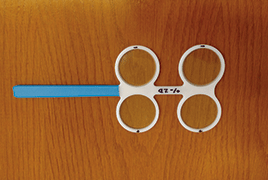The main goal of our study was to prove short-term objective influence of near addition and relieving prism on accommodative and vergence facility in group of young healthy persons. Further, we wanted to prove objective and subjective difference between two types of soft contact lenses during working with digital device. We had in total 37 subjects in our study. The first group contained 37 subjects with average age 23 years without important eye pathology. The second group contained 8 subjects with the same average age without important eye pathology. In the first group of subjects, we measured binocular accommodative facility (BAF) and binocular vergence facility (BVF) with and without addition 1 D and with and without relieving prism 2 pD BO at working distance 45 cm. In the second group, we evaluated BAF, BVF and standardized questionnaire (Computer Vision Syndrome Questionnaire – CVS-Q, Sequí M. 2015) during usage of two types of soft contact lenses. The first type of contact lenses (type 1) contained relieving prism for PC working and type 2 was soft contact lens with aspheric design. In the first group of subjects, we measured these values: BAF without addition = 12.78 cpm, BAF with addition = 11.57 cpm, BVF without prism = 12.32 cpm, BVF with prism = 11.59 cpm. In the second group of subjects, we measured with contact lens type 1 these values: BAF = 12.13 cpm, BVF = 13.63 cpm and questionnaire score 9.43 points. With contact lens type 2 we measured BAF = 11.75 cpm, BVF = 11.63 cpm and questionnaire score 12.86 points. We proved statistically important different between two variable only in the first group between BAF with and without addition and BVF with and without relieving prism. In conclusion, we found statistically important decrease in variable BAF and BVF with usage of addition and relieving prism. We found that neither addition nor prism have positive influence on increase of BAF and BVF. Subjects in second group had higher BAF and BVF values with both types of contact lenses in comparison with natural values. We found that with contact lens type 1 (with addition) subjects had higher BAF and BVF values in comparison with contact lens type 2 (aspheric). Subjects
with contact lens type 1 had also lower (better) questionnaire score, i.e. 9.43 versus 12.86 point.
- Diagnosis of Familial Hypercholesteroleamia on First Sight? The Role of the Ophthalmologist in Identifying patients with Familial Hypercholesteroleamia
- Vertical Strabismus - Indication of Surgical Techniques on the Inferior Rectus Muscle
- Keratopigmentation (Corneal Tattoo) - Our First Experience
- Correction od Myopia and Myopic Astigmatism by Implantation of a Phakic Posterior Chamber Implantable Collamer Lens
- Digital Eye Strain in a Population of Young Subjects
- The Effect of Multiple Variables on the Refractive Error After Cataract Surgery

